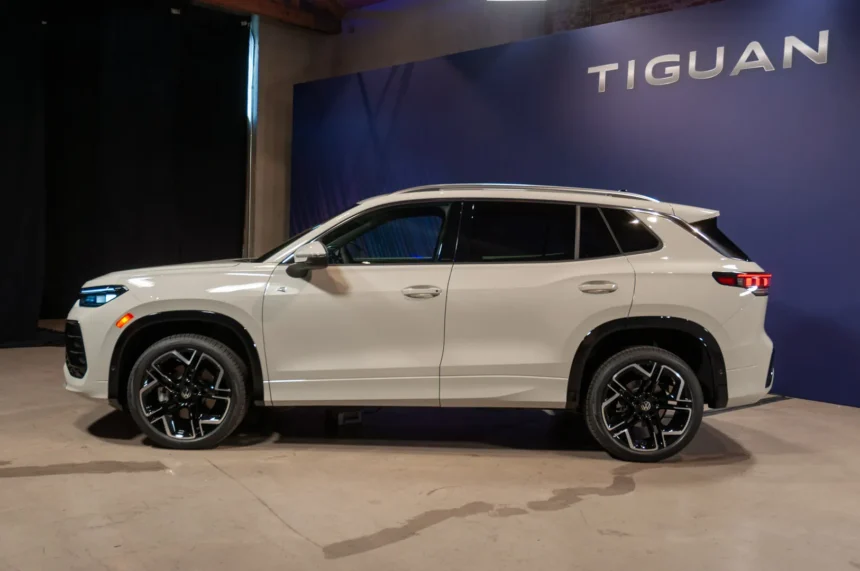The Tiguan’s seats are comfortable and supportive, with ample padding for long drives. The rear seats can slide and recline, giving passengers more flexibility and comfort. With 37.6 cubic feet of cargo space behind the rear seats, the Tiguan offers plenty of room for luggage and gear for weekend getaways.
How big is the Toyota RAV4?
The Toyota RAV4 is slightly smaller than the Tiguan, but still offers plenty of space for five passengers. The RAV4 has 37.8 inches of rear legroom, providing ample space for adult passengers in the back seat. The seats in the RAV4 are comfortable and supportive, making long drives more enjoyable.
With 37.6 cubic feet of cargo space behind the rear seats, the RAV4 offers similar cargo capacity to the Tiguan. The RAV4’s rear seats can also fold down to provide even more cargo space, making it easy to transport larger items when needed.
Advantage: Volkswagen Tiguan, for its larger size and more comfortable seats.

2025 Toyota RAV4 Plug-In Hybrid
Tiguan vs. RAV4 technology and features
- Tiguan has a larger infotainment screen
- RAV4 offers more standard safety features
- Both offer Apple CarPlay and Android Auto
What technology does the Volkswagen Tiguan offer?
The Volkswagen Tiguan comes equipped with a 12.9-inch infotainment touchscreen that supports wireless Apple CarPlay and Android Auto. The digital gauge cluster provides clear and easy-to-read information for the driver. Higher trim levels of the Tiguan offer features such as a 12-speaker Harmon Kardon sound system, heated and cooled front seats, and a heated steering wheel.
Standard safety features on the Tiguan include forward collision warning, automatic emergency braking, blind-spot monitoring, and rear cross-traffic alert. These features help to keep passengers safe and secure while driving.
What technology does the Toyota RAV4 offer?
The Toyota RAV4 comes with a 7.0-inch touchscreen infotainment system that supports both Apple CarPlay and Android Auto. Higher trim levels of the RAV4 offer a larger touchscreen, up to 9.0 inches, as well as additional features such as a power driver’s seat, keyless start, and heated front seats.
The RAV4 also comes standard with Toyota Safety Sense, which includes features such as lane departure warning, adaptive cruise control, and automatic high beams. These safety features help to prevent accidents and keep passengers safe on the road.
Advantage: Volkswagen Tiguan, for its larger infotainment screen and additional luxury features.
In conclusion, both the Volkswagen Tiguan and Toyota RAV4 offer a great combination of performance, technology, and comfort for buyers in the compact crossover SUV segment. The Tiguan stands out for its larger size, comfortable seats, and luxurious features, while the RAV4 excels in offering a wide range of models, hybrid options, and standard safety features.
Ultimately, the choice between the Tiguan and RAV4 will come down to personal preference and priorities. Whether you prioritize size and comfort or technology and safety, both the Tiguan and RAV4 are excellent choices for buyers looking for a versatile and practical crossover SUV.
The Toyota RAV4 and the Volkswagen Tiguan are two popular SUVs that offer plenty of space and versatility for drivers and passengers alike. When comparing the two, there are several key factors to consider, including size, fuel economy, styling, and safety features.
In terms of size, the Tiguan may look a little smaller on the outside, but it still offers plenty of interior space. With the rear seats folded down, the RAV4 has a cargo volume of 69.8 cubic feet, which is above average for its class. However, the Tiguan has a more spacious cabin with better seats, making it a more comfortable option for taller passengers.
When it comes to fuel economy, the RAV4 has the advantage, especially in its hybrid and plug-in hybrid versions. The RAV4 Hybrid with AWD gets an impressive 41 mpg city, 38 mpg highway, and 39 mpg combined, making it a cost-effective and efficient choice. The Tiguan, on the other hand, has average fuel economy ratings, with front-drive models earning 26 mpg combined and AWD versions getting 25 mpg combined.
In terms of styling, the RAV4 has a more adventurous and rugged look, while the Tiguan has a more conservative and stylish design. The RAV4’s exterior features chunky fenders and a broad face, while the Tiguan has embraced design cues from its ID.4 electric vehicle, including an LED light bar across the brow. Inside, the Tiguan has a more upscale and stylish cabin with a larger infotainment touchscreen and digital gauge cluster.
When it comes to safety, both the RAV4 and the Tiguan offer excellent crash-test scores and a range of advanced safety features. The RAV4 has earned a Top Safety Pick from the IIHS and a five-star overall rating from the NHTSA, while the Tiguan comes equipped with standard automatic emergency braking, blind-spot monitors, adaptive cruise control, and more.
Overall, the Toyota RAV4 comes out on top in this comparison, thanks to its excellent fuel economy, spacious interior, and impressive safety features. However, the Volkswagen Tiguan has its charms, including a stylish design and a generous warranty package. Ultimately, the choice between the two SUVs will depend on individual preferences and priorities. As the world continues to grapple with the ongoing crisis of the COVID-19 pandemic, there is a growing sense of urgency to find solutions that can help mitigate the spread of the virus. One such solution that has gained significant attention in recent months is the use of rapid antigen tests.
Rapid antigen tests are a type of diagnostic test that can quickly detect the presence of viral proteins in a person’s body. Unlike PCR tests, which require samples to be sent to a laboratory for analysis, rapid antigen tests can provide results in a matter of minutes, making them a valuable tool for quickly identifying individuals who may be infected with the virus.
The use of rapid antigen tests has been widely adopted in a number of settings, including schools, workplaces, and healthcare facilities. By providing rapid results, these tests can help identify and isolate individuals who may be carrying the virus, thereby helping to prevent further spread within communities.
One of the key advantages of rapid antigen tests is their speed and efficiency. With results available in as little as 15 minutes, these tests can provide real-time information that can help inform decision-making and guide public health interventions. This rapid turnaround time can be especially valuable in settings where quick action is needed to prevent outbreaks, such as in schools or nursing homes.
Another advantage of rapid antigen tests is their ease of use. Unlike PCR tests, which require specialized equipment and trained personnel to administer, rapid antigen tests can be easily administered by non-medical personnel, making them accessible to a wider range of individuals. This ease of use also makes rapid antigen tests a cost-effective option for mass testing campaigns, allowing for widespread screening of populations at risk.
Despite their many advantages, rapid antigen tests do have some limitations. One of the main drawbacks of these tests is their lower sensitivity compared to PCR tests. Rapid antigen tests are more likely to produce false negative results, especially in individuals with low viral loads or in the early stages of infection. As a result, it is important to confirm negative results with a PCR test, especially in individuals who are symptomatic or have been in close contact with a confirmed case.
Overall, rapid antigen tests have emerged as a valuable tool in the fight against COVID-19. By providing quick and easy access to testing, these tests can help identify and isolate infected individuals, thereby reducing the spread of the virus within communities. As the pandemic continues to evolve, rapid antigen tests will likely play an important role in helping to control outbreaks and protect public health.





